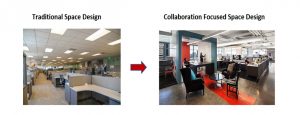Does your workplace strategy support your attraction and retention strategy?
Today, governmental agencies are challenged with an aging workforce where, on average, more than 25 percent of the workers are over 55 years old and 55 percent are over 45 years old. This demographic sets the stage for a human capital crisis if a significant percentage of these governmental workers retire without a new generation of workers coming in to mitigate the resulting loss in experience and intellectual capital.
Compounding this problem, governments at the federal, state and local level often find it more difficult to attract and retain talent than does the private sector. This is because the public sector cannot pay an equivalent salary to similarly skilled professionals in the private sector, and they typically have more static structures for advancement then in the private sector. Also, most governmental office environments are aging and offer fewer amenities than the private sector, which negatively impacts the employee experience that now typically includes modern offices, food options, fitness facilities and more.
Counterbalancing these challenges is the mission-driven nature of government work that provides employees the opportunity to directly and positively impact lives, and government jobs provide greater employment stability then the private sector during economic downturns. Nonetheless, these benefits often fail to overcome the allure of more money and faster career advancement in the private sector.
One way governmental organizations can compete for and retain talent is through its workplace strategy. The grand unplanned experiment with remote work during the pandemic revealed most organizations found their workforce continued to perform work at a high level while working remotely. More important, from the perspective of an attraction and retention strategy, a recent Gallup poll shows the workforce fell in love with improved work-life balance provided by having the flexibility to work remotely.
This doesn’t mean people never want to return to the office; in fact, study after study has shown that about two-thirds of the workforce desire to come into the office two to three days a week to collaborate and socialize with their peers. By providing the flexibility to work from home a few days a week and then coming to the office for collaborative work activities, a public sector organization can support both the work and the worker in a positive way.
Unfortunately, most government office spaces are designed to dedicate most of the space to individual work for things like offices and cubicles, which are out of step with a “collaboration first” emphasis. Moving forward, by providing “hoteled” workstations for those who work offsite more than two days a week, an organization can reduce its overall space requirements, allowing the creation of more team-based spaces without increasing the amount of real estate it uses.
If the old office was designed like a warehouse for workers with the odd conference room thrown in, the new office should be more like a dynamic conference center with a variety of team-based spaces and amenities designed to support complex collaboration and celebrate the culture of the organization. The government should also remember the “design matters” and create a dynamic environment that makes good use of color and light to generate a positive experience.


We are in a changing world where public and private organizations are grappling to develop a workplace strategy that address lessons learned about remote work and the profound changes in workforce expectations that resulted from the pandemic. By providing a flexible work strategy that blends onsite work with remote work, governmental organizations can for a reasonable investment add two critical tools to help them attract and retain the next Gen workforce:
- Design a quality “team first” environment at the office.
- Provide employees with enhanced work-life balance through the ability to work remotely several times a week.
Collectively, these changes will provide for more effective and attractive work environments that can entice people to work with for government and empower them to excel once they are there.
Bob Hunt leads a national Government and Education Advisory practice group in JLL that provides a wide range of real estate advisory services exclusively to government and higher education clients in the United States. His core focus is helping organizations link their real estate strategy to their overall business strategy. An expert on alternative development structures, Hunt is skilled at translating organizational needs into business cases and actionable performance criteria to support the planning, implementation and measurement of real estate and workplace strategies. Hunt brings more than 30 years of experience helping organizations develop real estate and workplace solutions, including real estate portfolio planning, facilities planning, development advisory, public private partnership (P3) formation, and real estate, information technology and human resources integration.



















